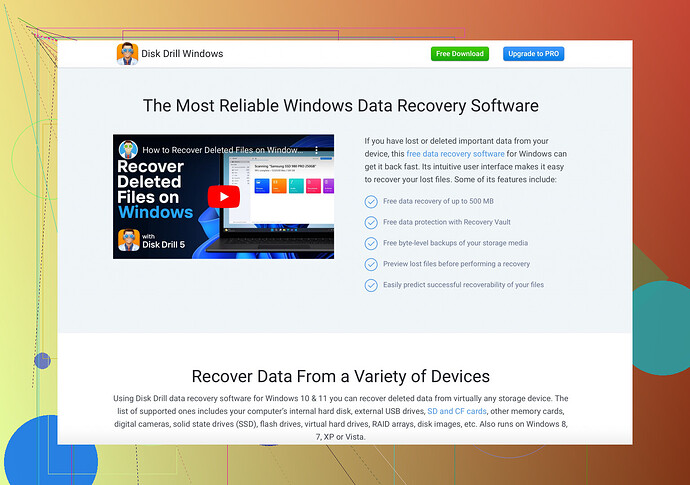My SD card stopped working, and I’m unable to access my files. I need an SD repair tool to try and fix it. Does anyone have recommendations for the best SD repair tool or steps on how to repair it? Thanks!
Alright, you’ve got an SD card that’s acting up. Don’t panic yet! First, try using an SD repair tool. I’ve had my fair share of experiences with them, and here’s what you can do:
-
Check Disk Utility (Windows) or First Aid (macOS):
- On Windows, open Command Prompt and type
chkdsk X: /f(replace X with your SD card letter). This command checks for disk errors and attempts to fix them. - On macOS, go to Disk Utility, select your SD card, and click ‘First Aid.’
- On Windows, open Command Prompt and type
-
Disk Drill:
If you need something more robust, grab Disk Drill Data Recovery Software. This gem can recover files from damaged SD cards. Just download it, scan your card, and it’ll attempt to recover your lost files. -
Formatting (Last Resort):
If nothing works, you might need to format the card. Use your device’s format option but keep in mind, this will erase everything. Make sure you have backups if possible.
Remember, SD cards have a limited lifespan, so if it’s dead, you might need to replace it. But these steps should give you a fighting chance to reclaim your files before calling it quits.
Oh man, nothing like an uncooperative SD card to ruin your day. Apart from the solid tips that @sternenwanderer gave you, here are a few more steps you might try before you go berserk and chuck that thing out the window:
-
Try a Different Device or Reader: Sometimes, the problem isn’t the card but the reader or the device itself. Test the SD card on another computer, camera, or phone. You might be surprised how often this simple step resolves the issue.
-
SD Card Formatter Tool: If you’re lucky, you might be able to fix it with the official SD Association’s own formatting tool. It’s specifically designed for SD/SDHC/SDXC cards. Sure, it’s formatting, so use as a last resort, but it does a cleaner job than the basic OS formatting options. You can download it from their site.
-
Recuva: Having a backup option is never a bad idea. If Disk Drill, for some reason, doesn’t cut it (yeah, hard to believe), you might wanna try Recuva. This is another tool that’s doing a pretty decent job at recovering stuff from problematic drives.
-
Check for Write Protection: Have you checked if the write-protection switch on the card is ON? It’s an easy miss. Toggle it a few times to see if it might just release the condition keeping your card locked.
-
Linux Live CD: Feeling adventurous? Boot your computer using a Linux Live CD/USB. Sometimes Linux can access drives that Windows and macOS can’t. Fire up GParted or TestDisk and give it a whirl.
-
Heating Up a Bit: This is more of a crazy trick, but some people swear by it – briefly heat the card (like under a lamp, NOT a torch or anything extreme). I guess the idea is it might fix minor physical deformities. Be careful and avoid melting it!
No one wants to mess around with failing tech, so fingers crossed for you. Sometimes all these efforts might just be a friendly reminder that it’s time for a new card. But hey, give it a shot and see how it rolls. ![]()
Alright, diving into SD card repair, I got some quirky and unconventional tricks up my sleeve you might find nifty!
1. Freezer Method (Desperation move): Wrap your SD card in a plastic bag and put it in the freezer for a couple of hours. Weird as it sounds, this trick sometimes helps with electrical contacts and might make your card readable long enough to get those files off. Just be quick about it!
2. SpinRite: Unlike other options like Disk Drill or Recuva, SpinRite works at a deeper level on the disk. It is an advanced data recovery utility for addressing problematic magnetic storage. Though it’s primarily for HDDs, it has been useful for SD cards with serious issues.
3. System File Checker Tool (Windows):
- Open Command Prompt as an admin.
- Type
sfc /scannow. This checks system files and automagically repairs any corruption that may indirectly affect your SD card’s function.
4. CCleaner: Beyond regular junk cleaning, CCleaner has been expanded with some recovery features (integrated with Recuva). Couple it with its sister tool and you get a more holistic system clean-up and recovery attempt.
Pros & Cons for Disk Drill:
Pros:
- User-friendly interface, hard to mess up.
- Supports a plethora of file systems.
Cons: - Can be pricey for the full version.
- Recovery success sometimes depends on the card’s condition and you may not get 100% of your files back.
5. Change Drive Letter (Windows): Sometimes the problem is as trivial as a conflicting drive letter. Assign your SD card a new letter in Disk Management to ensure it’s properly detected.
6. H2testw: This is a great tool to check the integrity of your SD card. It’ll tell you if your card is fake or has internal firmware issues. Run it to ensure your SD card is what it claims to be.
Tips Not to Overlook:
- Backup Regularly: Duh! But repeated for effect. Always have multiple backups.
- Avoid Continuous Rewrites: SD cards wear out. Use more robust hardware for data that undergoes frequent changes.
Lastly, even after all this, if nothing works, it’s about time to say goodbye to your trusty SD card and get a new one. Sometimes, it’s the only way forward. Good luck and may the digital gods favor you! ![]()
